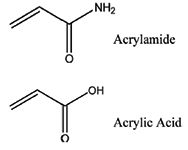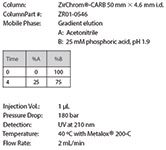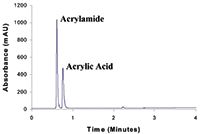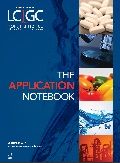Fast Separation of Acrylamide Monomer from Acrylic Acid
The Application Notebook
The unique selectivity, pH, and temperature stability of the ZirChrom®-CARB phase allows baseline resolution of acrylamide and acrylic acid using a 4-min gradient method.
Small polar molecules such as acrylamide and acrylic acid (see Figure 1) can be difficult if not impossible to separate on conventional reversed-phase bonded silica type phases using HPLC. Acrylamide historically has been analyzed using sample derivitization coupled with gas chromatography (1). The distinctive selectivity and increased retentiveness of the ZirChrom®-CARB phase, compared to bonded silica or polymeric phases, enables the baseline resolution of these small polar molecules.

Experimental
A mixture of acrylamide monomer and acrylic acid was separated using ZirChrom®-CARB.

This method is an excellent example of how the enlarged zirconia
method development "tool box" can be used to overcome the toughest separation challenges. Using temperature, extreme pH, and the unique surface chemistry of ZirChrom®-CARB a fast separation of acrylamide and acrylic acid was achieved using a 4-min gradient (see Figure 2).

This method can be tailored to your specific application needs. ZirChrom method developers can help you optimize and transfer this method to your site. Please contact ZirChrom technical support at 1-866-STABLE1 or support@zirchrom.com for details.
ZirChrom phases offer unique selectivity for ionic compounds, high efficiency, and excellent chemical and thermal stability.
Reference
(1) E. Tareke et al., "Acrylamide: A Cooking Carcinogen?" Chem. Red. Toxicol. 12, 517–522 (2000).

ZirChrom Separations, Inc.
617 Pierce Street, Anoka, MN 55303
tel. 1-866-STABLE-1, email: support@zirchrom.com
Website: www.zirchrom.com


.png&w=3840&q=75)

.png&w=3840&q=75)



.png&w=3840&q=75)



.png&w=3840&q=75)














